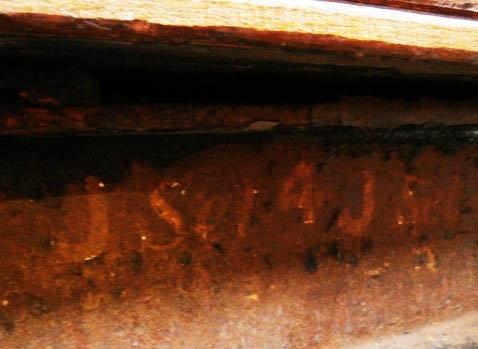TK Numbering
There is some dispute as to the numbers which our TK carried over its
service life with the LNER. Gresley's Coaches (Michael Harris, pub. David & Charles 1973) has
the coach built in 1924 originally numbered 10021, but with a running number of 1002. Confusion
increased with the discovery of "4464" stamped on some door ventilators.
It is generally agreed that the coach was renumbered to 12041 in 1943 and to SC12041E after
nationalisation in 1948. After transfer to departmental service in 1963, it carried DE1008 and
this was the number on the coach when it came into the possession of the SRPS in 1971.
"Andy W" on the LNER Encyclopedia forum says
'London North Eastern Railway passenger train vehicles - a monograph on the details and history
from 1924 until 1979 by C.J.G Bishop. Volume One - Corridor Thirds'
lists it as built as 10021J in 9/24,
renumbered to 1002 in 5/26, renumbered to 4464 in 12/30, renumbered to 12041 after 1943. Allocated to
ScR stock after nationalisation and condemned in 1/60. Converted to DE 320874 in 7/61 and preserved in 2/71.
It is also listed as being allocated to Flying Scotsman set 1 in 1928."
From "silverfox2512" on the LNER Encyclopedia forum - "I can add from a copy of the official Doncaster
DO list of renumberings that the renumbering of 4464 to 12041 to
Diagram 23 is confirmed. This ties in with Harris as original 10021J and 1002 in ECJ service".

The following comments were received from John Macnab in June 2020.
Built York to Diagram 23, Lot 47, it was one of a dozen so built being the first of
their kind, third corridors, of the LNER in 1924.
Two emerged in 8/24 (10019/20J), in 9/24 appeared 10021/2J, the remainder,
10023-5,27-32} in 11/24. (There was no 10026J for some reason).
The J denoted ECJS and shown, on paper at least, as "owned/allocated" to
Southern Area, Great Northern section.
They, with other types, formed six sets, numbered J1 to 6 on their solebars and
from October, 1924, onwards formed principal East Coast services such as the
"Flying Scotsman."
12041 is "our" one and initially bore the number 10021J (on paper at least
although this is not definite) as did the others but was quickly changed (as soon
as appearing/emerging so it seems) losing their fifth digit An all round 1925 (all
this within months) renumbering scheme change had 1002(1) become 4464 and,
it would appear, the J suffix was discontinued.
In 1943 the LNER decided on another all over renumbering scheme with, for
example and in the carriage types in question, third corridors numbered from
12000 onwards. With the exigencies of war and the soon to be nationalisation of
the railways from 1948 it is very likely the physical task of renumbering was
completed by then.
How the LNER created problems for themselves not to mention us researchers
having to make head or tail of it all!
12041 then came into being and in the 1953 allocation of passenger carrying
coaching stock (it took four years or so into BR days for Scotland to get its own
allocation, the task commencing in 1951) to the Scottish Region became SC
12041 E and along with 12040 (the erstwhile 10020J, 1002,4463) will be noted
(as per photo copy of page concerned) the two oldest LNER coaches of their type
in the Region (all others from 1925 onwards into the 1930's).
Withdrawal of 12041 (and 12040) is noted to have taken place in 1/60 and both
to Departmental Stock (DE 320873/4) for a period withdrawn again in 7/61.
In passing, it will be seen that the 1953 listing gives them 64 seats (without
armrests) although many others (pen altered) show only 48 seats (with
armrests, thereby seating 6 aside). Had 12041 always been the latter?
Revealing "J set 4" is intriguing after the passage of time and the relatively short lived period it was
identifiable as such on the workings given mention.
John Macnab June 2020
Close the window.